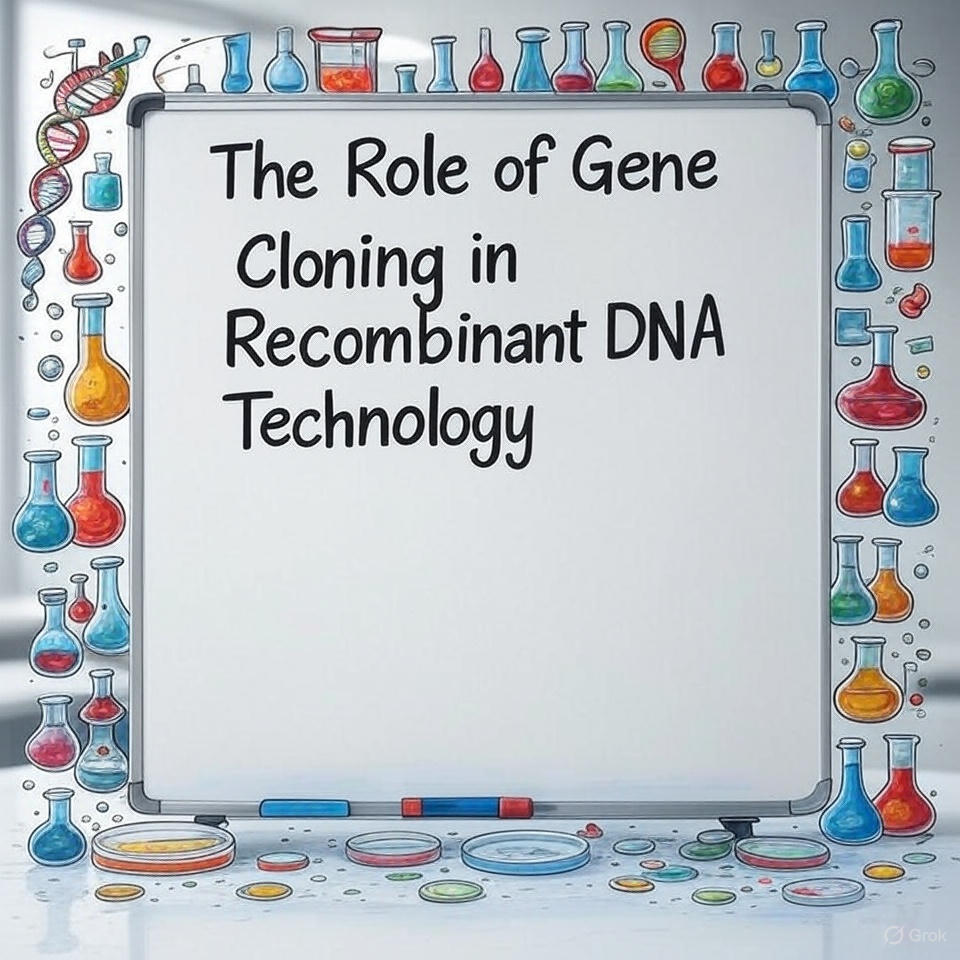Recombinant DNA technology uses enzymes and lab techniques to isolate, manipulate, and combine DNA segments from different species. The engineered DNA, known as recombinant DNA (rDNA), is replicated within bacterial or yeast cells. The word “cloning” refers to the formation of identical copies. Gene cloning is fundamental to recombinant DNA technology which is used to isolate, amplify, and produce rDNA.
rDNA is created in the lab by combining segments from natural chromosomes and plasmids. This technique enabled gene cloning, where specific DNA fragments are inserted into plasmids or viruses and replicated within bacterial or eukaryotic hosts. This allows the production of large quantities of specific proteins and the genetic modification of cells to express novel proteins.
The first rDNA molecules were created in 1973 by Paul Berg, Annie Chang, Stanley Cohen, and Herbert Boyer. In 1975, the Asilomar Conference was held to address the regulation and safe use of this new rDNA technology. Since then, it has been applied in various fields, including research, medicine, and agriculture.
Fundamentals of gene cloning
Gene cloning is a fundamental and widely used DNA manipulation technique due to its versatility, reliability, and cost-effectiveness. It involves assembling a gene of interest into recombinant DNA molecules. These molecules are then replicated within a host organism to produce multiple copies of the gene. Key components that make this gene cloning possible are:
- Restriction enzymes: act as molecular scissors that cut DNA at specific sequences. Restriction enzymes, originally found in bacteria to defend against foreign DNA, recognize and cut specific DNA sequences, while bacterial DNA is protected by methylation. Since the 1970s, molecular biologists have used these enzymes along with DNA polymerase and ligase to cut, manipulate, and analyze DNA, making them essential tools for genome mapping.
- DNA ligase: used to join the gene fragment with the DNA vector, sealing the recombinant DNA.
- DNA vector: a nucleic acid storage system that can autonomously replicate in a host, often bacteria, and is used to carry and combine DNA fragments from different organisms to create recombinant DNA constructs. Plasmids, which are preferred over phage vectors in laboratory work, have been extensively modified to improve DNA delivery and selection in bacterial hosts.
- Host cells: The vector is introduced into a host organism, which is cultured to replicate and produce many copies of the inserted DNA fragment. Clones containing the desired DNA are then identified, selected, and harvested for further use.
Recombinant DNA workflow
- Isolation of DNA: The first step in the recombinant DNA workflow involves DNA extraction from the organism containing the gene of interest.
- Preparation of cloning vectors: The extracted DNA segments are then inserted into vectors at specific sites, typically using a ‘cut-and-paste’ method with restriction endonucleases and DNA ligase. Vectors are engineered with a multiple cloning site (MCS), a region containing various restriction sites that allow flexibility in choosing enzymes for insertion. The MCS is strategically placed to avoid interfering with essential vector functions and may be positioned to enable regulation of the inserted DNA’s expression.
- Transformation into the host cells: The third step involves cloning the vector DNA into a host cell using methods such as transformation, transfection, transduction, or viral infection, depending the type of vector and host. Once inside, the vector either replicates independently using its sequences or integrates into the host chromosome. Vectors that cannot replicate on their own are called suicide vectors.
- Selection and screening of clones: The fourth step involves selecting cells that have successfully taken up the vector, as DNA uptake is typically inefficient. This is achieved using selectable marker genes on the vector, which allow transformed cells to survive antibiotic treatment or complement a metabolic defect under specific growth conditions.
- Propagation and expression: After the recombinant construct is established in a host cell, it can be used for various downstream applications. These include studying the phenotypic effects of the inserted genes, producing and purifying the encoded protein, or isolating the construct for further DNA manipulations like mutagenesis, mapping, or sequencing.
Applications
Gene cloning in recombinant DNA technology has been used for:
- Hormone production: Gene cloning has made groundbreaking innovations in biopharmaceuticals. In the late 1970s, scientists explored whether synthetic genes could be designed and expressed in bacteria such as E. coli. Recombinant DNA technology, allowed scientists to manipulate, clone, and amplify DNA for various applications. This technology has led to the production of cloned human proteins, such as insulin and growth hormone, as well as the development of safer vaccines. The breakthrough led to the first scalable production of human insulin, approved in 1982 for treating diabetes. It is also being used with cloned DNA probes to diagnose genetic disorders prenatally, helping prevent their clinical effects.
- Improving crop traits: Over the past 30 years, major advances in gene cloning have enabled the isolation of over 450 resistance genes important for plant immunity. Improved recombinant DNA technology, bioinformatics, and plant transformation have enabled the cloning of these genes in crop plants and their wild relatives. This progress opens the door to developing genetically disease-resistant crops, reducing reliance on pesticides.
- Bioremediation: Chemical and physical cleanup methods are costly and harmful, so bioremediation with genetically engineered microbes (GEMs) is becoming more popular. GEMs are designed to break down pollutants more effectively than natural microbes. This approach is safer, cheaper, and better for the environment and public health.
- Biotechnology research: Gene cloning in animal agriculture is used to enhance traits like milk production, growth rate, feed efficiency, and disease resistance. It also improves reproductive performance and enables the use of animals in biomedical research. For instance, recombinant bovine somatotropin (bST), approved by the FDA and 18 other countries, has been widely used in the U.S. dairy industry since 1994. It is now used in about half of U.S. dairy herds, increasing milk production by 10–15%, with higher gains possible under optimal management.
Ethical issues and regulatory monitoring
Gene cloning raises ethical concerns about potential misuse, unintended consequences in genetically modified organisms, human genetic manipulation, and impacts on biodiversity and the environment. While accepted in research, reproductive cloning sparks debate over identity, autonomy, and the protection of sensitive genetic information.
Three U.S. federal agencies—the food and drug administration (FDA), the environmental protection agency (EPA), and the U.S. department of agriculture (USDA), work together under the coordinated framework for the regulation of biotechnology to ensure GMOs are safe for human, animal, and environmental health.
The FDA oversees the safety of GMO foods, the EPA regulates pesticides and plant-incorporated protectants, and the USDA ensures GMO plants do not harm agriculture. Together, these agencies enforce strict safety standards for the development, use, and regulation of GMOs.






